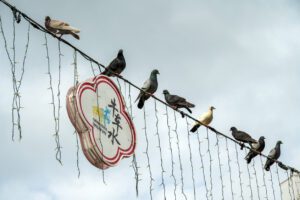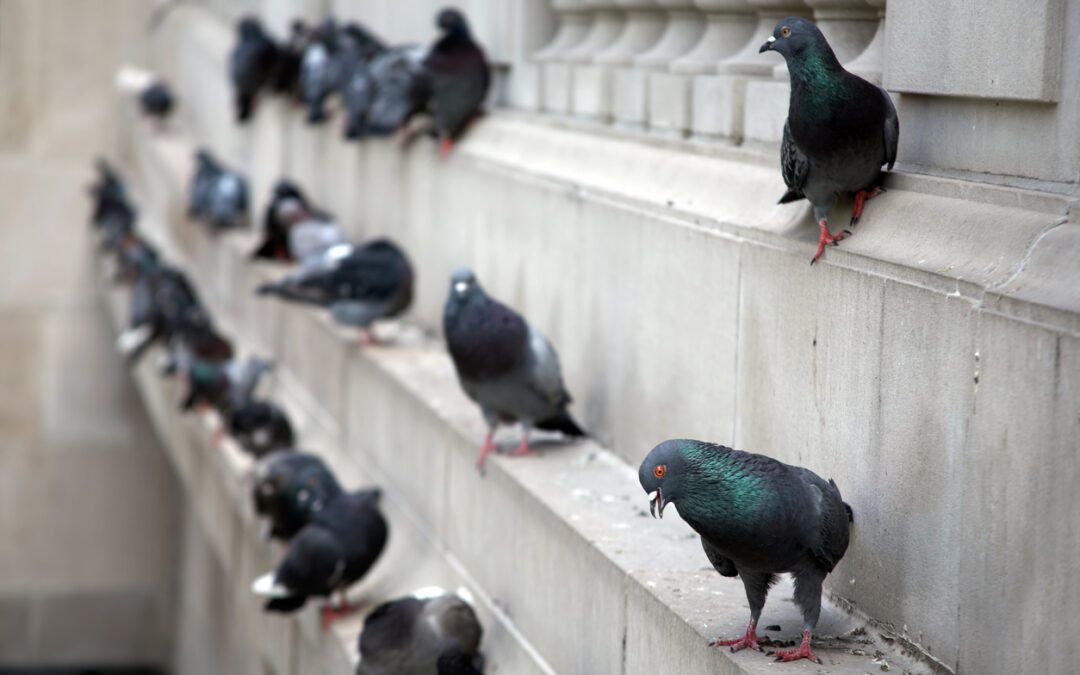More than 20 years ago, after a boozy bachelor party, three of us were walking across the small park at the intersection of State and Rush Streets. This, like many other parks large and small, is a place where pigeons congregate. Without a word of warning or “Hey, watch this,” the bachelor took a couple of quick steps and kicked an unsuspecting pigeon into the air. I saw the pigeon land with a thud 20 feet away but before I could say to the bachelor, “Why’d you kill that pigeon?” I watched in amazement as the pigeon shook its little head, got up on its skinny legs and went about its business. And I thought, “What a tough little bird.”

I didn’t give pigeons more thought until a few weeks ago when artist Tony Fitzpatrick–whose previous subjects in the Magazine have included fighting dogs, boxers, snakes and flowers–showed me his pigeon pictures. Here they are on this page and in my head’s a question: What do pigeons deserve? To be pitied, praised or punted?
There is no doubt that pigeons are the most urban of birds, the avian equivalent of squirrels or traffic jams; facts of city living to be either tolerated or complained about.
But listening to Megan Ross, curator of birds at Lincoln Park Zoo, talk about pigeons is to gain a new appreciation of them. “The species does get a bad rap,” she says. “But it is a fascinating species, if one takes the time to look.”
She points out that there are some 300 species of pigeons and doves. “What we commonly refer to in Chicago as a pigeon is actually a rock dove,” she says. Look closely and you will see that a pigeon is not just a dull gray mass, but a bird of 10,000 feathers, some of them bronze, pink, white and green. (Seriously, just take a look.) Watch them fly and you will also see what Ross describes as “fun flight patterns.” And, she adds, “They also have a nice courtship display.”
As well they should, since pigeons, it may surprise you to know, mate for life. Not only that, but male pigeons have the ability to lactate, producing milk for the babies just as females do.
Admittedly, when pigeons gather in groups, as they mostly seem to, they can exude the quiet menace of a gang. One almost expects to see some of them smoking cigarettes or spitting on the sidewalk.
“Rock doves are very docile birds,” says Ross. “They gather in groups not to intimidate people but as a protection against predators, such as falcons or raccoons. There is a certain safety in numbers.”
But their most common and persistent enemy is us. Besides various eradication efforts designed to limit their numbers, pigeons face determined campaigns by businesses to chase them away. Some even install fake owls on building ledges or set up loudspeakers that periodically emit terrible screeching, hawklike sounds in outdoor parking lots in an attempt to keep the CEO’s Jaguar clean.
“Many people are turned off by the fact that the birds poop,” says Ross.
This was not always the case. That people are turned off, I mean. In the 18th Century, King George I of England decreed all pigeon droppings to be property of the Crown. He even put guards at sites where the birds perched to enforce his edict. He was no birdbrain. There was a practical reason for his order: Pigeon manure was used in making gunpowder.
But if the birds have thus unknowingly contributed to the taking of lives, they have also done their bit to save them. With the ability to beat their wings up to 10 times a second, maintain a heart rate of 600 beats per minute for up to 16 hours without rest and fly as fast as 60 m.p.h., pigeons are the extreme athletes of the air.
In World War I, a homing pigeon named “Cher Ami” finished his distinguished career by delivering, while wounded, a vital message: the location of the famous “Lost Battalion,” thereby saving some 200 human lives. In WWII, a homing pigeon named “GI Joe” saved more than 1,000 allied soldiers’ lives in a single mission.
Who knows if Chicago pigeons would be up to such valorous deeds? But they are tough characters.
They do not migrate, as do more sensible species, and take the full brunt of Chicago winters. Unlike the rest of us, they do not whine about the wind chill. They seem capable of eating almost anything, from popcorn in the parks to abandoned pizza slices, old hamburger buns to cotton candy. “They have, shall we say, a hearty digestive system,” says Ross.
They don’t seem to be at all insecure about their looks, though people vastly prefer spunky sparrows.
They appear to be fearless, not only when confronted by the attacks from businesses but from individuals. Many little kids like to chase them. Older kids try to hit them with rocks or kick them. Some adults hunt and kill them for food. Though we were unable to catch any of these folks in the act of hunting, cooking or eating, the Internet is filled with recipes for pigeon.
All this, and pigeons can still live to be more than 30 years old.
It’s so easy to take everyday things for granted. When was the last time you watched a river or stream flow, looked up at a building’s decorative elements, scooped up a handful of sand or dirt or asked the name of your local Streetwise vendor?
So, why not give pigeons another look? Start with the ones fashioned by Fitzpatrick and then move on to the real things, to the resilient birds with which you share the sidewalks and park benches.
Pigeon Patrol Products & Services is the leading manufacturer and distributor of bird deterrent (control) products in Canada. Pigeon Patrol products have solved pest bird problems in industrial, commercial, and residential settings since 2000, by using safe and humane bird deterrents with only bird and animal -friendly solutions. At Pigeon Patrol, we manufacture and offer a variety of bird deterrents, ranging from Ultra-flex Bird Spikes with UV protection, Bird Netting, 4-S Bird Gel and the best Ultrasonic and audible sound devices on the market today.
Canada’s top wholesaler for bird deterrent products for twelve consecutive years.
Contact us at 1- 877– 4– NO-BIRD, (604) 585-9279 or visit our website at https://www.pigeonpatrol.ca/
Bird Gone, Pigeon Gone, Pigeon problems, pigeon spikes, 1-877-4NO-BIRD, 4-S Gel, Bird Control, Pigeon Control, bird repellent, Bird Spikes, sonic bird repellent, stainless steel bird spikes, bird spikes Vancouver, Ultra Sonic Bird Control, Bird Netting, Plastic Bird Spikes, Canada bird spike deterrents, Pigeon Pests, B Gone Pigeon, Pigeon Patrol, pest controller, pest control operator, pest control technician, Pigeon Control Products, humane pigeon spikes, pigeon deterrents, pigeon traps, Pigeon repellents, Sound & Laser Deterrents, wildlife control, raccoon, skunk, squirrel deterrent, De-Fence Spikes, Dragons Den, Pigeon, Pigeon Patrol, Pigeons Roosting, Vancouver Pigeon Control, Bird Spikes, Bird Control, Bird Deterrent, Pigeon Deterrent, Surrey Pigeon Control, Pest, Seagull deterrent Vancouver Pigeon Blog, Birds Inside Home De-fence, Pigeon Nesting, Bird Droppings, Pigeon Dropping, woodpecker control, Keep The Birds Away, Birds/rats, seagull, pigeon, woodpecker, dove, sparrow, pidgeon control, pidgeon problem, pidgeon control, flying rats, pigeon Problems, bird netting, bird gel, bird spray, bird nails, bird guard, Pigeon control, Bird deterrents, Pigeon deterrents, Bird control, solutions, Pigeon prevention, Pigeon repellent, Bird proofing, Pest bird management, Pigeon spikes, Bird netting, Humane bird control, Bird exclusion, Urban bird control, Anti-roosting devices, Pigeon removal, Bird barriers

